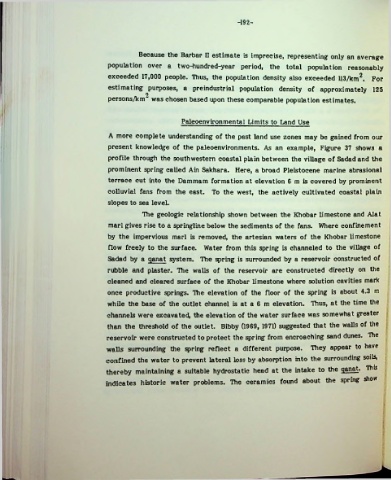Page 216 - Life & Land Use on the Bahrain Islands (Curtis E Larsen)
P. 216
-192-
Because the Barbar n estimate is imprecise, representing only an average
population over a two-hundred-year period, the total population reasonably
exceeded 17,000 people. Thus, the population density also exceeded U3/km2. For
estimating purposes, a preindustrial population density of approximately 125
2
persons/km was chosen based upon these comparable population estimates.
Paleoenv iron mental Limits to Land Use
A more complete understanding of the past land use zones may be gained from our
present knowledge of the paleoenvironments. As an example, Figure 37 shows a
profile through the southwestern coastal plain between the village of Sadad and the
prominent spring called Ain Sakhara. Here, a broad Pleistocene marine abrasional
terrace cut into the Dammam formation at elevation 6 m is covered by prominent
colluvial fans from the east. To the west, the actively cultivated coastal plain
slopes to sea level.
The geologic relationship shown between the Khobar limestone and Alat
marl gives rise to a springline below the sediments of the fans. Where confinement
by the impervious marl is removed, the artesian waters of the Khobar limestone
flow freely to the surface. Water from this spring is channeled to the village of
Sadad by a qanat system. The spring is surrounded by a reservoir constructed of
rubble and plaster. The walls of the reservoir are constructed directly on the
cleaned and cleared surface of the Khobar limestone where solution cavities mark
once productive springs. The elevation of the floor of the spring is about 4.3 m
while the base of the outlet channel is at a 6 m elevation. Thus, at the time the
channels were excavated, the elevation of the water surface was somewhat greater
than the threshold of the outlet. Bibby (1969, 1971) suggested that the walls of the
reservoir were constructed to protect the spring from encroaching sand dunes.
walls surrounding the spring reflect a different purpose. They appear to have
confined the water to prevent lateral loss by absorption into the surrounding soils,
thereby maintaining a suitable hydrostatic head at the intake to the <janat. This
indicates historic water problems. Tlie ceramics found about the spring show

